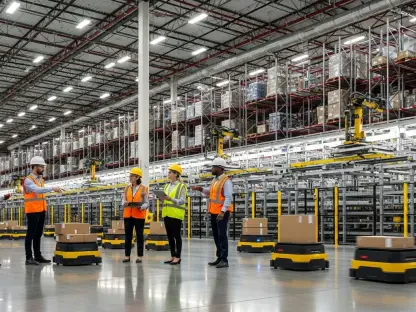In an era where remote work has become a norm rather than an exception, organizations face a pivotal challenge: equipping their workforce to thrive amidst rapidly evolving technological and cultural landscapes. As companies transition to remote-first operations, adapting to fluctuating market needs while aligning with employee expectations is essential. This requires redefining traditional recruitment, leveraging technology like AI responsibly, and prioritizing employee wellbeing. Chief People Officer Barbara Matthews from Remote, a global HR platform, offers valuable insights into crafting a holistic approach to talent acquisition and management. By understanding and implementing strategies that focus on flexibility, AI integration, and comprehensive wellbeing, businesses can establish a workforce prepared for the future.
Redefining Value Proposition in Talent Acquisition
As businesses navigate the complexities of modern recruitment, it becomes evident that candidates today value more than just monetary compensation and job titles. The evolving job market has sparked a shift in priorities, where potential employees increasingly seek stability, work-life balance, and robust career progression paths. According to a survey involving 2,000 U.S. workers, these factors outweigh financial rewards, revealing that only a small fraction of employees feel they receive adequate support to thrive in their roles. This gap presents a significant challenge for organizations as they strive to attract and retain top talent by meeting these changing expectations. To address this disconnect, Matthews stresses that HR leaders must restructure their talent acquisition strategies to go beyond traditional offerings. Highlighting the importance of organizational stability and career growth, companies should craft communications that resonate with candidates’ aspirations. This requires shifting the narrative to focus on selling the overall experience, ensuring that potential hires understand how the company’s culture aligns with their personal and professional goals.
Additionally, finding success in talent acquisition involves tailoring the company’s value proposition to reflect the diverse needs and preferences of the modern workforce. As Matthews underscores, flexibility in work arrangements is now a critical consideration for job seekers. The findings from Remote indicate that nearly all employees prioritize such flexibility when considering new roles. Organizations must therefore adapt by offering not only competitive salaries but also opportunities for remote work, flexible hours, and supportive career development environments. By aligning with job seekers’ expectations, businesses can create a compelling value proposition that appeals to a broader talent pool and differentiates them from competitors.
Navigating Generational Diversity in the Workplace
The current workforce landscape is characterized by generational diversity that demands nuanced recruitment strategies. With baby boomers, Generation X, millennials, and Generation Z coexisting in the workplace, each group carries distinct values, communication styles, and expectations. Older generations often prioritize job stability and structured career paths, while their younger counterparts gravitate toward flexibility and work-life integration. This diversity presents a multifaceted challenge for HR leaders aiming to effectively engage and retain talent across generations. To address these complexities, Matthews advises crafting tailored communication strategies that account for the unique priorities of each generational cohort. Creating a workplace environment where individuals feel heard and valued requires HR professionals to establish clear communication frameworks. Implementing tools like personal “user manuals” can aid in conveying individual expectations, feedback styles, and communication preferences. By fostering a culture of understanding and mutual respect, organizations can enhance cross-generational engagement and foster collaboration.
Furthermore, successful management of generational diversity involves providing opportunities for professional growth and mentorship that resonate with each age group. Organizations should actively create spaces where employees from various generations can share insights, experiences, and skills. By facilitating mentoring relationships between older and younger workers, companies can facilitate knowledge transfer while addressing the distinct needs of each group. Such initiatives not only contribute to a positive workplace culture but also enhance overall organizational performance. Prioritizing a generationally inclusive environment is crucial for attracting and retaining employees who feel aligned with the company’s mission. As businesses strive for sustainability and growth, leveraging the strengths of each generation contributes to a dynamic and diverse workforce ready to tackle contemporary challenges.
Integrating AI Responsibly in Recruitment Processes
The incorporation of artificial intelligence into recruitment processes marks a significant advancement in the field of human resources, offering efficiency and innovation. However, the rapid evolution of AI technology presents both opportunities and challenges that demand careful consideration. While AI can streamline administrative tasks and enhance candidate-job matching, it also poses risks related to biases and inaccuracies. A study by Insight Global revealed widespread redundancies in AI-generated applications, illustrating the importance of a cautious approach. To balance the benefits and pitfalls of AI, Matthews emphasizes the need for thoughtful and responsible integration into recruitment processes. AI can effectively automate repetitive tasks, freeing up HR professionals to focus on more strategic aspects of recruitment. However, maintaining transparency and fairness is imperative, particularly when it comes to data privacy and compliance with related laws. Incorporating AI responsibly requires organizations to implement safeguards that ensure algorithmic decisions do not compromise diversity and inclusion efforts.
Moreover, the ultimate responsibility for hiring decisions must remain with humans to preserve the emotional intelligence and empathy that machines cannot replicate. While AI provides valuable data and insights, the final evaluation of candidates should consider qualitative factors that machines may overlook. This human touch ensures a more comprehensive understanding of candidates’ potential contributions beyond technical qualifications. By combining AI-driven efficiency with human intuition, organizations can make informed hiring choices that align with their culture and values. Adopting a balanced approach to AI in recruitment requires continuous evaluation and adaptability to emerging technologies. Organizations must remain vigilant in monitoring AI systems to identify any unintended biases or inaccuracies promptly. By doing so, businesses can harness the power of AI to enhance their recruitment strategies while maintaining ethical standards and promoting inclusivity. Ultimately, the responsible integration of AI into recruitment processes ensures that organizations remain competitive in an ever-evolving job market.
Promoting Transparency in Remote Hiring
In the absence of face-to-face interactions, building trust and rapport with potential candidates remotely poses distinctive challenges. As remote hiring becomes increasingly prevalent, fostering transparency throughout the recruitment process becomes vital to establishing credibility and confidence among prospective employees. Within Remote’s operations, transparency is championed through an ethos of “no surprises,” where comprehensive information about job stages, processes, benefits, salaries, and decision timelines is readily available from the outset. Matthews underscores the significance of creating an open culture where candidates receive a holistic view of the organization before joining. By providing clear insights into the hiring process, organizations can cultivate trust and encourage engagement among prospective hires. Additionally, publishing employee handbooks enables candidates to access essential information that aligns with their personal values and career aspirations.
Beyond transparency in recruitment, effective onboarding practices play a crucial role in fostering a sense of belonging and connection among remote teams. Innovative onboarding strategies, such as scheduled virtual coffee chats, facilitate meaningful connections between new hires and their colleagues. These interactions create a supportive environment where employees can share their experiences and build relationships despite geographical distances. Furthermore, maintaining consistency in hiring efforts across global operations necessitates regional teams operating within a unified framework. By aligning regional insights with core organizational values, companies can achieve coherence in their messaging while accommodating local needs. This approach ensures a cohesive and harmonious culture that resonates with both candidates and employees worldwide.
Addressing Declining Wellbeing and Resilience
In today’s complex recruitment landscape, it’s clear that job seekers value more than just salary and prestigious titles. The job market is evolving, with candidates prioritizing stability, work-life balance, and clear career advancement opportunities over financial incentives. A survey of 2,000 U.S. workers highlighted this trend, showing that only a small percentage of employees feel adequately supported in their roles. This reality poses a challenge for businesses aiming to attract and retain top talent by meeting these shifting expectations. Matthews advises that HR leaders must reshape their recruitment strategies, emphasizing stability and growth opportunities. Companies need to communicate in a way that resonates with candidates’ personal and professional aspirations, focusing on the entire work experience. Furthermore, success in attracting talent requires adapting the company’s value proposition to the diverse needs of today’s workforce. As Matthews points out, flexibility in work arrangements—such as remote work and flexible hours—is essential for many job seekers. By offering these elements, alongside competitive pay, organizations can enhance their appeal to a wider range of potential employees, setting themselves apart in the competitive job market.









